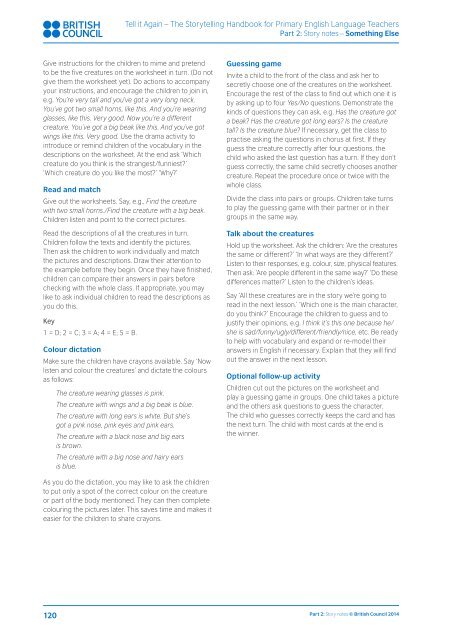1nW0gvB
1nW0gvB
1nW0gvB
You also want an ePaper? Increase the reach of your titles
YUMPU automatically turns print PDFs into web optimized ePapers that Google loves.
Tell it Again – The Storytelling Handbook for Primary English Language Teachers<br />
Part 2: Story notes – Something Else<br />
Give instructions for the children to mime and pretend<br />
to be the five creatures on the worksheet in turn. (Do not<br />
give them the worksheet yet). Do actions to accompany<br />
your instructions, and encourage the children to join in,<br />
e.g. You’re very tall and you’ve got a very long neck.<br />
You’ve got two small horns, like this. And you’re wearing<br />
glasses, like this. Very good. Now you’re a different<br />
creature. You’ve got a big beak like this. And you’ve got<br />
wings like this. Very good. Use the drama activity to<br />
introduce or remind children of the vocabulary in the<br />
descriptions on the worksheet. At the end ask ‘Which<br />
creature do you think is the strangest/funniest?’<br />
‘Which creature do you like the most?’ ‘Why?’<br />
Read and match<br />
Give out the worksheets. Say, e.g., Find the creature<br />
with two small horns./Find the creature with a big beak.<br />
Children listen and point to the correct pictures.<br />
Read the descriptions of all the creatures in turn.<br />
Children follow the texts and identify the pictures.<br />
Then ask the children to work individually and match<br />
the pictures and descriptions. Draw their attention to<br />
the example before they begin. Once they have finished,<br />
children can compare their answers in pairs before<br />
checking with the whole class. If appropriate, you may<br />
like to ask individual children to read the descriptions as<br />
you do this.<br />
Key<br />
1 = D; 2 = C; 3 = A; 4 = E; 5 = B.<br />
Colour dictation<br />
Make sure the children have crayons available. Say ‘Now<br />
listen and colour the creatures’ and dictate the colours<br />
as follows:<br />
The creature wearing glasses is pink.<br />
The creature with wings and a big beak is blue.<br />
The creature with long ears is white. But she’s<br />
got a pink nose, pink eyes and pink ears.<br />
The creature with a black nose and big ears<br />
is brown.<br />
The creature with a big nose and hairy ears<br />
is blue.<br />
Guessing game<br />
Invite a child to the front of the class and ask her to<br />
secretly choose one of the creatures on the worksheet.<br />
Encourage the rest of the class to find out which one it is<br />
by asking up to four Yes/No questions. Demonstrate the<br />
kinds of questions they can ask, e.g. Has the creature got<br />
a beak? Has the creature got long ears? Is the creature<br />
tall? Is the creature blue? If necessary, get the class to<br />
practise asking the questions in chorus at first. If they<br />
guess the creature correctly after four questions, the<br />
child who asked the last question has a turn. If they don’t<br />
guess correctly, the same child secretly chooses another<br />
creature. Repeat the procedure once or twice with the<br />
whole class.<br />
Divide the class into pairs or groups. Children take turns<br />
to play the guessing game with their partner or in their<br />
groups in the same way.<br />
Talk about the creatures<br />
Hold up the worksheet. Ask the children: ‘Are the creatures<br />
the same or different?’ ‘In what ways are they different?’<br />
Listen to their responses, e.g. colour, size, physical features.<br />
Then ask: ‘Are people different in the same way?’ ‘Do these<br />
differences matter?’ Listen to the children’s ideas.<br />
Say ‘All these creatures are in the story we’re going to<br />
read in the next lesson.’ ‘Which one is the main character,<br />
do you think?’ Encourage the children to guess and to<br />
justify their opinions, e.g. I think it’s this one because he/<br />
she is sad/funny/ugly/different/friendly/nice, etc. Be ready<br />
to help with vocabulary and expand or re-model their<br />
answers in English if necessary. Explain that they will find<br />
out the answer in the next lesson.<br />
Optional follow-up activity<br />
Children cut out the pictures on the worksheet and<br />
play a guessing game in groups. One child takes a picture<br />
and the others ask questions to guess the character.<br />
The child who guesses correctly keeps the card and has<br />
the next turn. The child with most cards at the end is<br />
the winner.<br />
As you do the dictation, you may like to ask the children<br />
to put only a spot of the correct colour on the creature<br />
or part of the body mentioned. They can then complete<br />
colouring the pictures later. This saves time and makes it<br />
easier for the children to share crayons.<br />
120<br />
Part 2: Story notes © British Council 2014


